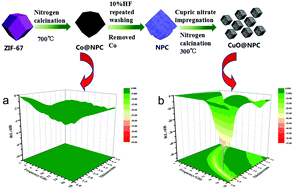Direct synthesis of MOF-derived nanoporous CuO/carbon composites for high impedance matching and advanced microwave absorption
Abstract
Nanostructured carbon materials with hollow structures derived from metal organic frameworks (MOFs) have attracted considerable attention due to their low density for microwave absorption. However, their poor impedance matching worsens the absorption properties. The rational design and fabrication of complex hollow nanocarbon materials with excellent impedance matching still remains a challenge. Herein, we report a simple strategy to fabricate porous CuO/carbon composites by nitrate impregnation into a MOF template (thermal decomposition of zeolitic imidazolate frameworks, ZIF-67). When used as microwave absorbing materials, these hollow CuO/carbon composite polyhedra exhibited excellent impedance matching, light weight and strong absorption. An optimal reflection loss (RL) of −57.5 dB is achieved at 14.9 GHz with a matching thickness of 1.55 mm and RL values less than −10 dB can be gained in the range of 13–17.7 GHz. The best absorbing performance of the composites mainly originates from the high loss of the porous carbon obtained by the carbonization of ZIF-67, and the improvement of the impedance matching with the embedding of CuO. This work may provide a general way for fabricating porous metal oxides/carbon composites for lightweight microwave absorbing materials.

- This article is part of the themed collection: 2016 Journal of Materials Chemistry C Hot Papers

 Please wait while we load your content...
Please wait while we load your content...